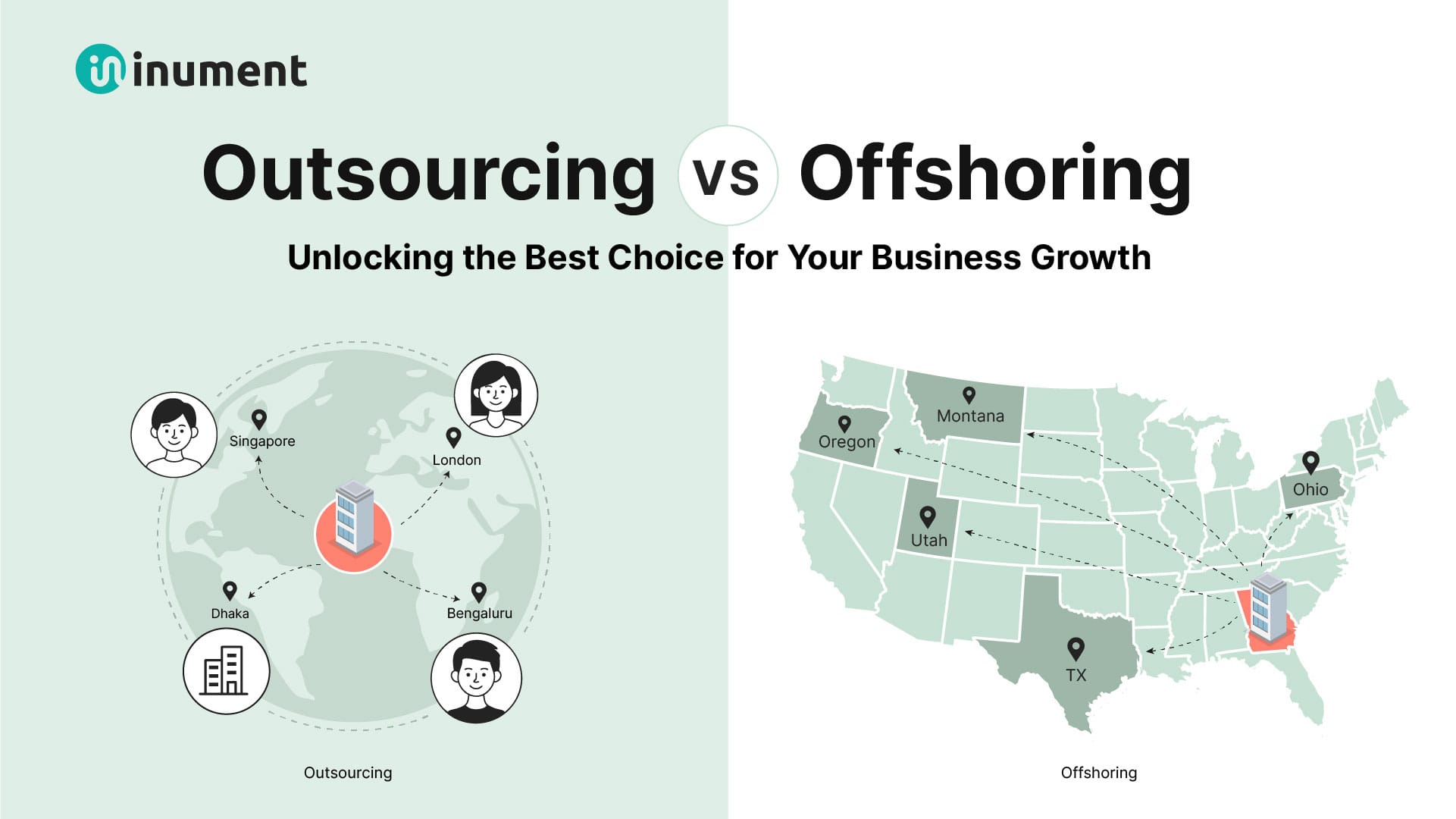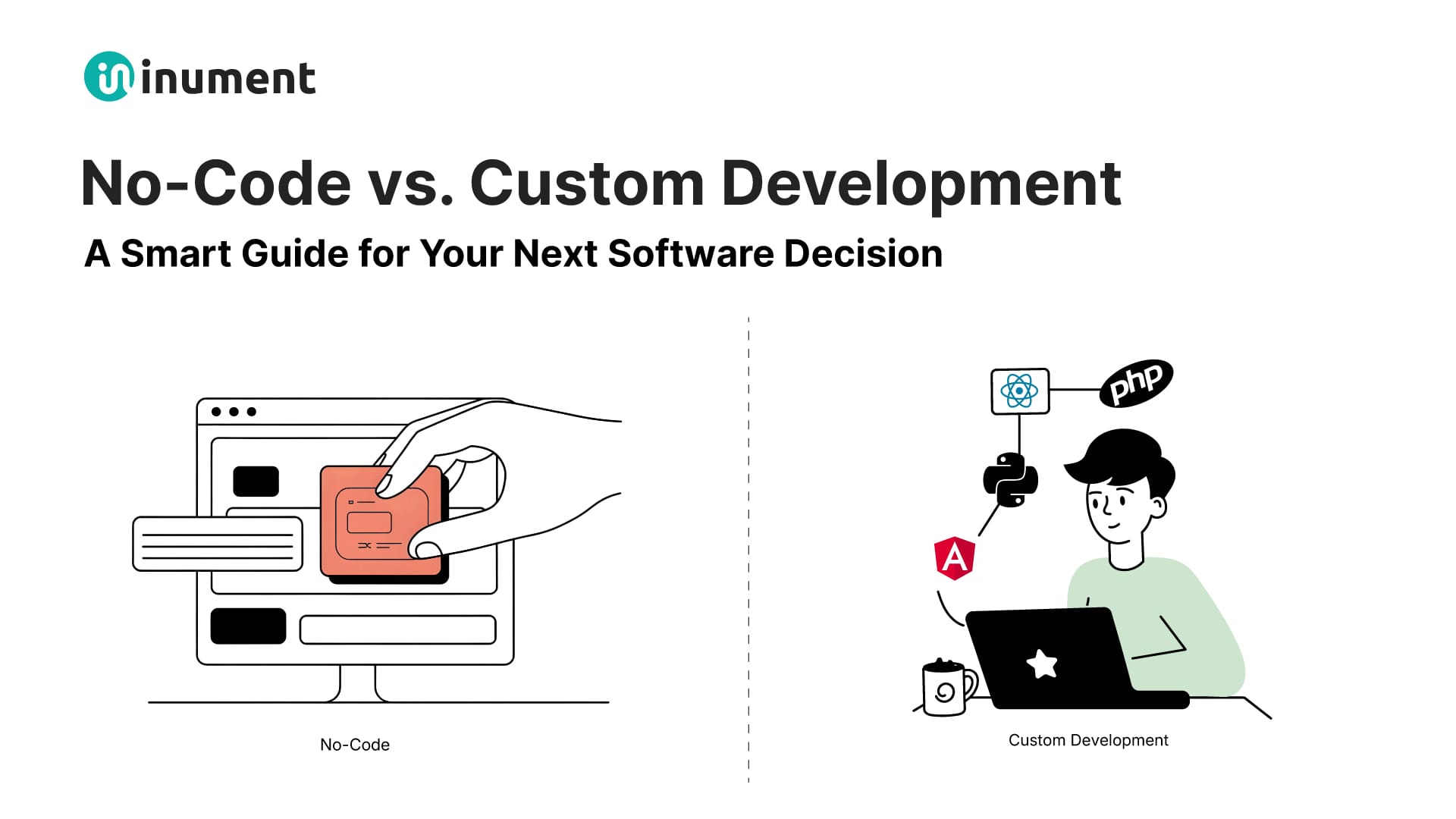In a world where remote-first work has evolved from a trend into the new norm, businesses are no longer confined by borders, or even time zones. This shift has fueled the rapid rise of many project management models.
Today, we’re exploring two of them: outsourcing and offshoring. Though often used interchangeably, these approaches are fundamentally different, and each carries its own impact on cost, control, collaboration, and long-term scalability.
In short: Outsourcing allows you to hand off specific tasks or entire projects to an external service provider, often with quick turnarounds and minimal overhead. Offshoring, on the other hand, is about relocating business operations to another country, often to tap into specialized skills or more cost-effective labor markets.
So, how do you know which approach is right for your business?
In this guide, we’ll break down the key differences between outsourcing and offshoring, explore their unique pros and cons, and help you choose the right model based on your goals, team structure, and growth strategy.
Let’s get right into it!
What Is Outsourcing?
At its core, outsourcing is the practice of contracting specific business functions, tasks, or projects to a third-party service provider; often outside of your organization, and sometimes even outside your country.
Rather than building internal teams for every function, businesses “outsource” work to external experts who already have the resources, infrastructure, and experience in place.
The primary advantage of outsourcing is that this model allows companies to focus on their core competencies while offloading tasks like software development, IT support, customer service, HR, and more to specialized vendors.

Source: Devox Software
For example, let’s say you have a software development company in the US, and are facing a tight deadline or talent shortage to develop a cutting-edge mobile app. You can easily outsource that project to a tech firm in Europe or Asia.
From UI/UX to backend development, the vendor will handle the entire process while you can focus on branding, marketing, and customer acquisition in your region.
The outsourced work can be delivered on a project basis, hourly engagement, or through long-term partnerships, depending on business needs. Outsourcing is highly flexible and can seamlessly scale with your business.
Here are the most common types of outsourcing you can try out:
- eCommerce Outsourcing: Product listing, Order fulfilment, Inventory tracking
- Marketing & Creative Outsourcing: Content creation, design, SEO, social media
- Business Process Outsourcing (BPO): Customer service, payroll, data entry, HR
- IT Outsourcing (ITO): Software development, infrastructure support, testing, DevOps
- Knowledge Process Outsourcing (KPO): Legal services, analytics, research, consulting
- Engineering Process Outsourcing (EPO): Product development, Prototyping, Industrial design
Pros and Cons of Outsourcing
From building MVPs to expanding product features or accelerating delivery timelines, outsourcing has become a go-to strategy for software development. But like any strategic decision, it comes with its own set of trade-offs. Let’s explore:
Pros of Outsourcing
- You get access to a global talent pool with specialized expertise minus the hiring or training cost.
- Experienced professionals can help speed up your time-to-market without adding complexity.
- You can scale teams up or down based on your business goals; without long-term commitments.
- Your internal team can focus on vision, strategy, marketing, or other high-impact, strategic areas.
- Developers in lower-cost regions (e.g., Eastern Europe, South Asia, Latin America) can significantly reduce operational overhead and fixed costs.
Cons of Outsourcing
- Unless you manage the project clearly, outsourced teams may drift from your vision or standards.
- Working with external vendors may increase exposure to data breaches or IP theft.
- Time zone gaps, language barriers, and asynchronous workflows can slow down feedback loops and lead to misalignment around quality, timelines, or collaboration style.
In essence, outsourcing is all about delegating execution while retaining oversight. It’s especially powerful for businesses needing speed, flexibility, and cost-efficiency; without the responsibility of managing additional employees or infrastructure.
What Is Offshoring?
Next, let’s talk about offshoring. Offshoring is the strategic practice of relocating business operations, or parts of them, to a different country, typically where costs are lower or where there’s access to specialized talent.
Unlike outsourcing, which focuses on delegating tasks to a third-party provider, offshoring can be done either through an external vendor or by setting up your own remote team or office (called a “Offshore Development Center or ODC”).
The primary goal of offshoring is to gain economic advantage; whether that’s through reduced labor costs, 24/7 productivity via time zone differences, or tapping into deep tech talent markets in regions like India, Ukraine, the Philippines, or Latin America.

Source: Pearl Talent
Following the previous example, let’s say your US-based company opens a development hub (ODC) in Dhaka, Bangladesh to handle all backend engineering. Your company will still hire directly and set your workflow/culture, but will benefit significantly from lower costs and a strong local talent pool.
Here are the main types of offshoring:
- Production Offshoring: hardware manufacturing, assembly and distribution.
- Service Offshoring: Customer service, IT support, cloud management services.
- Process Offshoring: DevOps Operations, QA Processes, software documentation.
- R&D Offshoring: AI/ML Model Training, Blockchain prototypes, MVP development, A/B testing.
- IT/Software Development Offshoring: Product Engineering, Web/App development.
- Staff Offshoring (Dedicated Remote Teams): UI/UX, engineering, and development.
- Hybrid Offshoring: You manage some parts of your workflow and the vendor handles the rest.
Pros and Cons of Outsourcing
Offshoring software development has become a strategic pillar for startups and enterprises alike. This approach enables faster delivery, wider talent access, and long-term cost control.
However, it also brings its own set of operational and cultural challenges. Let’s break it down:
Pros of Offshoring
- You get access to a global talent pool with specialized expertise without the overhead.
- It can help slash your total development costs by up to 40–70% without sacrificing quality.
- Accelerate your time-to-market and ensure 24/7 availability through teams in different time zones.
- Build larger, dedicated teams over time without the cost and compliance burden of hiring locally.
- Develop captive centers or hybrid setups where your offshore team becomes a true extension of your core team.
Cons of Offshoring
- Time zone differences and language barriers can slow down feedback loops, especially during agile sprints, daily stand-ups, or critical project phases.
- Getting offshore teams aligned with your workflows, tools, and codebase takes time and effort, especially in remote-first or hybrid setups.
- While labor is cheaper, managing distributed teams requires strong internal processes; from documentation and version control to quality assurance and stakeholder alignment.
In short, offshoring software development offers long-term ROI and scalability, especially for businesses with mature internal leadership and well-defined processes. But to succeed, you must treat your offshore team as an integral part of your product, not just a remote cost-saving function.
Offshoring vs Outsourcing: Key Differences
At first glance, outsourcing and offshoring might seem like two sides of the same coin as they both aim to reduce costs, improve efficiency, and expand access to global talent.
But in reality, they’re distinct strategies that impact your workflow, control, and business outcomes in very different ways.
So, what are the differences between outsourcing and offshoring?
Now that you have a solid understanding of what offshoring and outsourcing are, how they work, and their pros/cons; let’s move onto the core differences that set these two approaches apart.
1. Cost Structure
In offshoring, you hire directly or through a staffing partner, and the rates are usually lower than local hires and without vendor markup. Offshoring offers more cost transparency and is generally more cost-effective for long-term or ongoing development.
Conversely, in outsourcing, you typically pay a vendor for project-based or hourly work, and the cost includes vendor management, tools, infrastructure, and their profit margin. This makes budgeting predictable for fixed-scope work, but long-term outsourcing can become expensive due to markup layers.
2. Flexibility and Scalability
Offshoring lets you scale your teams up or down quickly depending on internal goals or sprint velocity. Whether building a dedicated team or hybrid squad, offshoring gives you more control over how and when to grow your capacity.
On the flip side, scaling in outsourcing typically means renegotiating contracts or onboarding a new vendor team. Vendors may not allow granular scaling (e.g., adding just 1-2 engineers mid-project). It’s less flexible once the project scope is locked.

Source: Dreamix
3. Level of Control & Ownership
Offshore teams work under your processes, follow your tech stack, and report to your leads. You maintain full control over deliverables, quality, and velocity.
In contrast, you’re just outsourcing the outcome, not the team. The vendor controls how the project is executed, and you may have little say in tooling, coding practices, or daily decisions.
4. Cultural and Communication Factors
With dedicated offshore teams, you can train them in your culture, workflows, and communication standards. Tools like Slack, Zoom, and Notion enable real-time engagement across distributed teams.
In outsourcing, however, most communication flows through a project manager. Time zone differences, language gaps, and lack of real-time collaboration can lead to misalignment; especially in agile environments.
5. Risk and Legal Considerations
With direct offshore teams, you manage the delivery risk. However, legal exposure increases if local laws don’t strongly enforce IP or labor protections.
Also, the political and economical instability of that country can also impact your outcome. That’s why choosing a reputable offshore partner and legal safeguards is key.
Inversely, in outsourcing, the vendor bears execution risks, but you’re still exposed to risks like missed deadlines, vendor bankruptcy, or code quality issues. Legal frameworks depend on the vendor’s country, which may offer limited recourse.
6. Data Security and Compliance
Offshoring lets you enforce your own data policies, VPNs, and access controls with offshore teams; especially if they’re dedicated. It’s easier to align offshoring with enterprise-grade security standards.
However, since vendors often use their own infrastructure and tools, you have less visibility into how data is handled. This can raise concerns with GDPR, HIPAA, or SOC 2 compliance.
7. Talent Access and Expertise
Offshoring lets you handpick engineers or build dedicated pods with the exact skill sets you need; across frontend, backend, DevOps, SQA, or AI. The team becomes an extension of your in-house capability
In contrast, outsourcing vendors plug-and-play teams with relevant experience that can have an impact from day one; but you don’t always get to choose who works on your project, and they may rotate staff between clients.
Here’s a comprehensive comparison table summarizing the key differences between offshoring and outsourcing:

Outsourcing or Offshoring: Which One You Should Choose
Whether you’re a startup racing to launch or an enterprise navigating digital transformation, one thing is clear: access to global talent and operational efficiency is no longer optional, it’s strategic.
But how should you go about it? Should you opt-in for offshoring, or outsourcing?
Deciding between outsourcing and offshoring isn’t just a matter of cost. It’s a strategic choice that depends on your goals, project complexity, internal bandwidth, and long-term vision. Let’s break down the factors that’ll help you decide when to choose one over the other.
Choose Outsourcing if —
- You need fast delivery with minimal management overhead. For example, one-off projects, MVP development, or when you’re short on internal leadership, outsourcing gives you quick wins with vendor-led execution.
- Your team lacks the required technical expertise. Outsourcing brings pre-assembled teams with domain-specific skills, so you don’t need to spend months hiring or training.
- You’re working with a clearly defined project scope. When the product roadmap is stable, and deliverables are fixed, outsourcing ensures predictable timelines and costs.
- You want to avoid HR, infrastructure, and admin responsibilities. In outsourcing, vendors manage the team, tools, payroll, and delivery. You focus on the outcomes, not on the operations.
- You need to scale fast, temporarily. Outsourcing is ideal for short-term sprints, rapid prototyping, or seasonal spikes without long-term commitments.
Choose Offshoring if —
- You want full control over how your product is built. Offshoring allows you to manage the team, set processes, and maintain quality standards; just like an in-house team.
- You’re building a long-term product and need consistency. Offshoring helps you retain knowledge, reduce churn, and create continuity across product releases.
- You have internal Project Managers (PM) or tech leads. If you can provide direction, offshore teams will integrate seamlessly and execute your roadmap.
- You’re scaling operations and need cost-effective growth. Offshoring enables you to build a larger team without increasing local overhead or headcount.
- You care deeply about IP, data privacy, and culture alignment. Dedicated offshore teams can be trained on your protocols, values, and tools; giving you more control and security.
To give you an example, many startups start with outsourcing to launch fast, then transition to offshoring when they’re ready to scale and take more ownership.
In today’s hyper-competitive tech landscape, how you build is just as important as what you build. Whether you choose outsourcing for speed and focus, or offshoring for control and long-term scalability, the key lies in matching the model to your business goals, internal capabilities, and product vision.
How Inument Helps You Make the Right Call
At Inument, we understand that choosing between outsourcing, offshoring, or staff augmentation isn’t just about picking a model. It’s about aligning your growth goals with the right execution strategy. And we’re here to help you do exactly that.
Whether you’re launching a product under tight deadlines, scaling an engineering team for long-term development, or bridging a short-term skill gap, Inument offers flexible engagement models tailored to your needs.
Our distributed teams bring deep technical expertise, while our leadership remains actively involved in project alignment, quality, and delivery. From scaling fast to testing and deploying MVPs, we help you choose and shift between models as your needs evolve.
From eCommerce and fintech to SaaS and AI/ML; Inument has delivered success across industries with precision and speed. Whether you’re still weighing your options or already clear on what you need, Inument can guide you to the right strategy and deliver results you can trust.
Wrapping Up: Clarity Leads to Confidence
Today, modern businesses aren’t just outsourcing to save money. They’re doing it to move faster, stay lean, and stay competitive. And offshoring isn’t just about cheap labor. It’s about building global centers of excellence that support long-term growth.
In essence, outsourcing gives you fast execution with minimal management overhead: ideal for well-defined, outcome-driven projects. Offshoring empowers you with a cost-effective, scalable team under your direction: perfect for growing digital products over the long term.
However, no matter which route you choose, having a trusted partner makes all the difference.
That’s where Inument comes in. We help you cut through the confusion, align your strategy with your goals, and build software that scales; on your terms.
If you’re looking for more insights on how Inument can help you scale your business, feel free to explore our in-depth blog section. Also, stay tuned for more guidelines on how to build and manage global tech teams.
Want to talk through your next move?
Reach out today, and we can help you choose the best solution that will streamline your growth!






